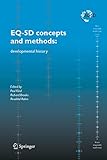EQ-5D concepts and methods: A developmental history / edited by Paul Kind, Richard Brooks, Rosalind Rabin.
Tipo de material: TextoEditor: Dordrecht : Springer Netherlands, 2005Descripción: xxii, 240 páginas recurso en líneaTipo de contenido:
TextoEditor: Dordrecht : Springer Netherlands, 2005Descripción: xxii, 240 páginas recurso en líneaTipo de contenido: - texto
- computadora
- recurso en línea
- 9781402037122
- R-RZ
Springer eBooks
The EuroQol Instrument -- The descriptive system of the EuroQol Instrument -- The number of levels in the descriptive system -- First steps to assessing semantic equivalence of the EuroQol Instrument: Results of a questionnaire survey to members of the EuroQol Group -- Comparing general health related quality of life (HRQoL) questionnaires; EuroQol, Sickness Impact Profile and Rosser Index -- Influence of self-rated health and related variables on EuroQol-valuation of health states in a Spanish population -- Observations on one hundred students filling in the EuroQol questionnaire -- Eliciting EuroQol descriptive data and utility scale values from inpatients -- Test-retest reliability of health state valuations collected with the EuroQol questionnaire -- Hypothetical valuations of health states versus patients’ self-ratings -- Inconsistency and health state valuations -- Issues in the harmonisation of valuation and modeling -- Estimating a parametric relation between health description and health valuation using the EuroQol Instrument -- Some considerations concerning negative values for EQ-5D health states -- Health states considered worse than ‘being dead’ -- The effect of duration on the values given to the EuroQol states -- Applying paired comparisons models to EQ-5D valuations - deriving TTO utilities from ordinal preference data -- The use and usefulness of the EuroQol EQ-5D: Preliminary results from an international survey -- Not a quick fix -- Postscript.
The EuroQol Group is an international, cross-disciplinary group set up in 1987 to investigate issues related to the valuation of health. This book presents a series of papers from the early 1990s that illustrate many key aspects of the development of EQ-5D including: the descriptive system, self-rated health, valuation issues, health status scaling, modeling and valuation, semantic issues, reliability, and comparison with other instruments. The book provides a detailed insight into the analytical processes involved in the development of the EQ-5D as one of the foremost instruments for the measurement and valuation of health-related quality of life, and will be of particular interest to researchers in this area. It will also appeal to all those involved in outcome measurement - clinical personnel, health policy advisers and administrators, those involved in audit and quality assurance, health economists, and the pharmaceutical industry.
Para consulta fuera de la UANL se requiere clave de acceso remoto.


